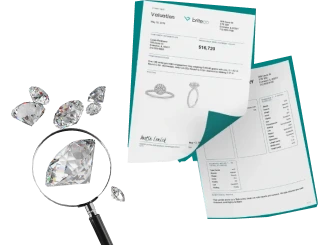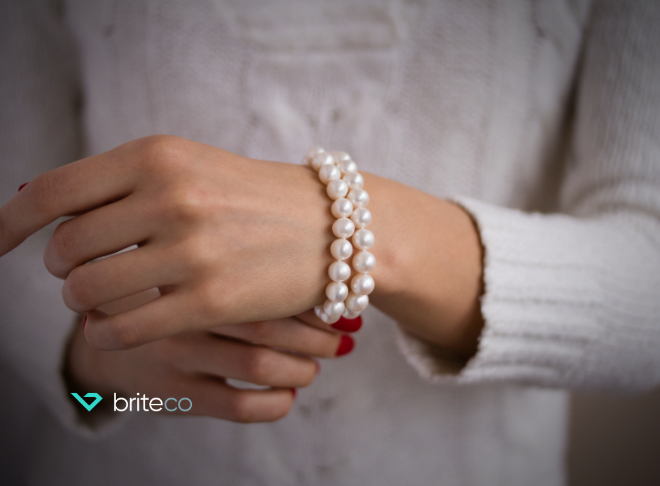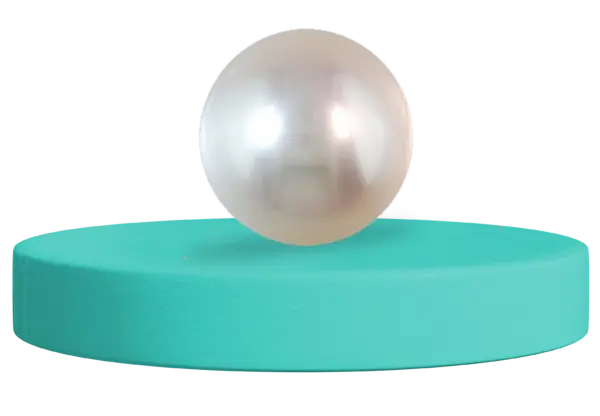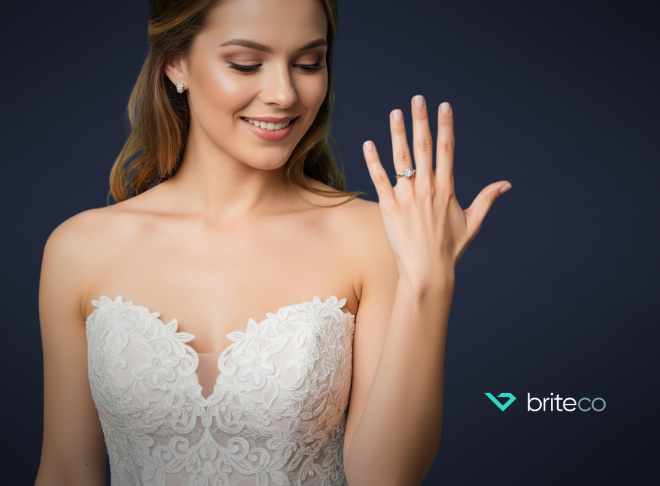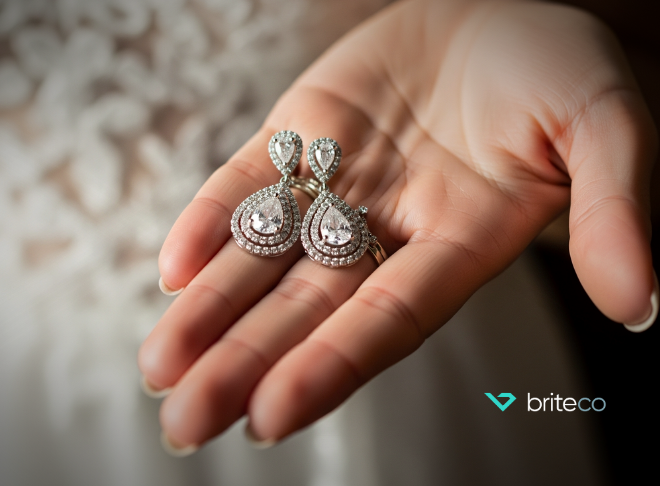Bakelite jewelry is striking. Collectors are often retro jewelry enthusiasts and/or fond of the Art Deco era. Keep reading to learn how to recognize Bakelite pieces and which pieces hold the greatest value for collectors.
What You Will Learn
What is Bakelite Jewelry?
During the Art Deco era, from 1909 to the 1940s, Bakelite jewelry, or costume jewelry made from a type of early plastic, gained widespread popularity. This jewelry was affordable and could enhance an ensemble or add flair to an outfit.
Dr. Leo Baekeland developed Bakelite in the early 20th century when he discovered that this new material cooled rapidly once heated and then maintained its solidity irrespective of temperature fluctuations. He secured a patent for this innovative substance in 1907.
Crafting Bakelite involves heating it to a liquid state and then molding it into various shapes and forms. It’s found applications in various products, including children’s toys and electronic components.
Bakelite was never intended as a luxury item but to provide those with limited financial means access to high-quality goods. The peak popularity of Bakelite jewelry occurred in the late 1930s, coinciding with the culmination of the Art Deco era. Major retail outlets, such as Sears, prominently featured Bakelite designs. Even renowned designers and luxury brands, including Chanel and Van Cleef & Arpels, embraced Bakelite in their jewelry creations. However, the use of Bakelite diminished in the early 1940s as manufacturing priorities shifted toward producing goods for World War II. Post-war advancements in plastic technology eventually rendered Bakelite obsolete.
How is Bakelite Made?
Bakelite, a distinct early plastic, is created by merging phenol with formaldehyde. These substances are molded into rods, which are then meticulously hand-finished to enhance their appearance.
This traditional approach sets Bakelite apart from contemporary plastic jewelry, which is typically crafted using precision molds. Each Bakelite piece, whether it’s a bangle bracelet or beads, undergoes a unique transformation, often involving hand carving or polishing to achieve the piece’s final form.
- Alternative Materials
Similar phenolic resin-based materials were later marketed under various brands globally. Celluloid and Lucite are two notable alternatives used in vintage jewelry. Celluloid, an early plastic predating Bakelite, is characterized by its delicate, translucent quality. Lucite, emerging in the 1930s, is notable for its crystal-clear appearance. Bakelite items, like bangle bracelets or beads, are generally heavier than their counterparts of the same size.
Popular Bakelite Colors
While originally available in a spectrum of hues, such as red, brown, blue, green, black, and white, vintage Bakelite jewelry’s colors have evolved further due to chemical interactions with the environment. For example, what was once an ivory-colored Bakelite piece may now have a golden-brown tint, and jewelry that was originally blue might now have a greenish hue. (Bakelite in transparent red stands out as particularly coveted by collectors.)
Popular Bakelite Jewelry Styles

Some of the most popular Bakelite jewelry includes:
- Bakelite Bangles and Bracelets: These accessories came in various forms, including solid bands and interlinked patterns.
- Bakelite Necklaces: You’ll find a range of diverse Bakelite necklace designs, including substantial bead strands, bold chokers, and intricately molded or carved pendants.
- Original Pins and Brooches: These pieces range from playful animal motifs to elegant floral designs. Many feature sparkling rhinestones embedded in the Bakelite.
How Much is Bakelite Worth?
Regardless of the style, authentic Bakelite jewelry holds significant value. Many necklaces and bracelets can fetch around $100 per piece, and more complex designs featuring multiple hues or detailed carvings can command prices in the hundreds or even thousands. In contrast, a very plain bangle bracelet with minimal decorative features might be available for around $30, and simple earrings or brooches often fall into a similar price bracket.
Elements Influencing Bakelite Jewelry Prices
Several key factors influence the value of vintage jewelry, particularly Bakelite items:
- Craftsmanship: Highly prized pieces often feature intricate carvings, paintings, or layers of materials. Bakelite items displaying a variety of colors are also highly prized.
- Historical appeal: Designs with specific themes, such as avian-shaped brooches or intricate floral patterns, are coveted for their distinct and charming appearance. Collectors also seek out items with polka-dot designs.
- Physical condition: Bakelite is known for its durability and longevity. Nevertheless, any signs of wear, such as scratches, cracks, or chips, can diminish the Bakelite jewelry value. Original components like pins, clasps, and earring backs should also be intact.
- Color rarity: Uncommon colors can significantly increase Bakelite jewelry value. For example, true turquoise-colored Bakelite is especially valuable due to its tendency to develop a greenish tint over time. Similarly, pieces in translucent shades are often among the most valuable Bakelite jewelry.
How To Identify Bakelite Jewelry
To confirm the authenticity of a piece of Bakelite jewelry, look for these distinctive features:
- No Seams: Thanks to the unique manufacturing methods used, Bakelite jewelry is seamless.
- Construction Elements: When examining vintage Bakelite jewelry, pay attention to the construction elements, such as jump rings, clasps, original pin backs, and/or hooks. These construction elements can offer clues about the jewelry’s age. For example, vintage brooches often have original pin backs that are riveted or screwed, rather than glued.
How to Test Bakelite
There’s more than one test you can use to confirm authenticity of vintage Bakelite jewelry.
The Hot Pin Test
If you gently press a heated pin against the jewelry, genuine Bakelite, known for its heat resistance, will remain unaffected.
The Simichrome Test
Another effective technique uses Simichrome polish, a common metal polish. To perform this Bakelite test:
- Apply a tiny dab of Simichrome polish to a soft cloth or cotton swab.
- Rub it gently onto a discreet part of the jewelry for about 30 seconds.
- Examine the soft cloth or swab; a yellowish or ivory stain suggests the item is likely authentic Bakelite.
The Rubbing Test
The rubbing test is another practical method, especially if you’re attempting to test a piece of Bakelite in an antique shop or flea market, where other tests may be less feasible. Vigorously rub the Bakelite with your finger to generate heat and friction. If the piece is real Bakelite, you’ll smell a distinct formaldehyde scent.
The Hot Water Test
Immerse the Bakelite piece in hot water and then smell it. You should notice the odor of formaldehyde.
These methods, whether using a hot pin, Simichrome polish, or sensory tests like rubbing or hot water, are essential tools for collectors and enthusiasts to confirm authenticity of vintage Bakelite bangles, bracelets, beads, and other early plastics. Each test offers a way to appreciate and price vintage Bakelite jewelry accurately.
Suggested Read: How to Identify Vintage Jewelry?
Why is Bakelite Jewelry So Expensive?
If it’s just plastic, why is Bakelite so expensive?
Bakelite jewelry has become a highly sought-after collector’s item and, as such, commands high value at high-profile auctions. For instance, one collection auctioned at Doyle in New York included pieces like a cuff with a green-on-orange crosshatch inlay that sold for $6,000, far exceeding its $800 estimate.
Some of the most expensive Bakelite jewelry is connected to renowned figures and brands. Pieces worn by celebrities like Elizabeth Taylor or created by famous designers like Coco Chanel and Auguste Bonaz attract higher prices. Chanel’s Bakelite designs, considered the pinnacle of the material’s elegance, are particularly coveted, with pieces from the 1930s considered extremely rare Bakelite jewelry and highly valued.
Tips for Cleaning and Caring for Bakelite Jewelry
As time passes, Bakelite acquires a unique patina due to the interaction between its chemical components and the air and environment. This patina adds to its charm, making it vital to clean Bakelite pieces with care so as not to remove them. To clean Bakelite jewelry:
- Create a mild cleaning solution using lukewarm water and a small amount of gentle dish soap. Carefully wash the jewelry.
- After cleaning, rinse the Bakelite thoroughly. Solid pieces can be rinsed directly under a stream of water, while non-solid items should be gently wiped with a cloth moistened in clean water to remove any remaining soap.
- Pat the Bakelite dry using a fresh, soft cloth, and allow it to air dry completely, especially in areas the cloth cannot reach.
Is Bakelite Jewelry Safe to Wear?
Bakelite jewelry is considered on par with other types of plastic accessories in terms of wearability. The primary risk associated with Bakelite occurs during its production phase due to chemical exposure.
FAQs
Can I learn how to identify vintage Bakelite jewelry?
Yes! You can learn how to identify Bakelite easily. A common identification test is to simply rub a suspected piece vigorously until warm and then sniff for a formaldehyde-like smell, which indicates authentic Bakelite.
What is Bakelite worth? Is Bakelite jewelry worth money?
Bakelite’s value varies greatly depending on factors such as rarity, condition, design, and historical significance. Particularly rare or intricate pieces can be worth a significant amount, with some items fetching thousands of dollars.
How do you test Bakelite?
You can use several tests to authenticate vintage Bakelite jewelry, including the hot pin test, Simichrome polish, and sensory tests employing friction and hot water.
Protect Your Investment
At BriteCo, we provide comprehensive and affordable jewelry insurance. Our policies include protection against loss, theft, and damage anywhere in the world, so you can rest assured that your vintage Bakelite jewelry is protected and in good hands.
To learn more, contact us directly or use our convenient online tool to obtain a personalized insurance quote.
Related Articles:
Step-By-Step Guide: How to Solder Jewelry?
How Should I Pack My Jewelry for a Move?
Protect your jewelry this summer
How to Buy Jewelry: Tips and Tricks from the Pros
Complex World Of Jewelry Stamps And What They Mean
Ancient Greek Jewelry
Serpentine Jewelry | BriteCo Jewelry Insurance
What are Cultured Pearls?





